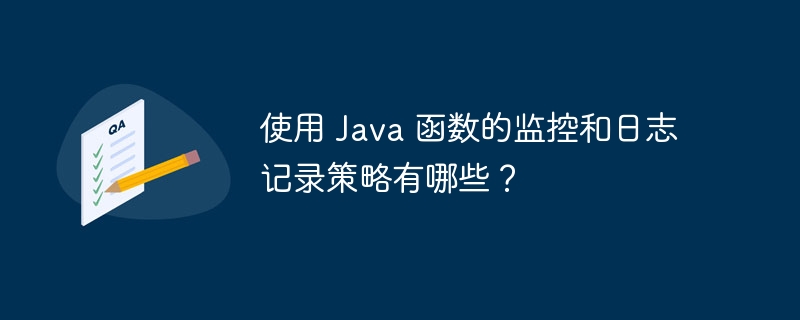監控和日誌記錄 Java 函數的策略:監控:使用 Cloud Monitoring API:提供對效能和指標的可見性。發送自訂指標資料點和時間序列。日誌記錄:使用 Stackdriver Logging:記錄事件,進行偵錯和故障排除。使用 Cloud Logging API:傳送和接收日誌條目。透過 Stackdriver Logging:直接記錄,提供方便的日誌語句和設定。

使用Java 函數的監控與日誌記錄策略
簡介
監控和日誌記錄對於維護穩定可靠的Java 函數至關重要。本文討論了在 Java 函數中實作這些策略的不同方法。
監控
import com.google.cloud.functions.HttpFunction;
import com.google.cloud.functions.HttpRequest;
import com.google.cloud.functions.HttpResponse;
import com.google.cloud.monitoring.v3.MetricServiceClient;
import com.google.monitoring.v3.CustomMetric;
import com.google.monitoring.v3.ProjectName;
import com.google.monitoring.v3.TimeInterval;
import com.google.monitoring.v3.TimeSeries;
import com.google.protobuf.Struct;
import com.google.protobuf.Value;
import java.io.IOException;
import java.io.PrintWriter;
import java.util.Date;
public class Monitor implements HttpFunction {
private static final String projectId = System.getenv("GOOGLE_CLOUD_PROJECT");
private static final MetricServiceClient metricClient = MetricServiceClient.create();
private static final ProjectName projectName = ProjectName.of(projectId);
@Override
public void service(HttpRequest request, HttpResponse response)
throws IOException {
var writer = new PrintWriter(response.getWriter());
// 创建一个自定义指标
var metric =
CustomMetric.newBuilder()
.setType("custom.googleapis.com/my_metric")
.setMetricKind(CustomMetric.MetricKind.GAUGE)
.setValueType(CustomMetric.ValueType.DOUBLE)
.build();
// 发送指标数据点
var requestBuilder = TimeSeries.newBuilder()
.setMetric(metric.getName())
.setResource(projectName.toString())
.addMetrics(
CustomMetric.newBuilder()
.setDoubleValue(Math.random() * 100)
.build());
var timestamp = new Date().getTime() / 1000.0;
requestBuilder.setInterval(
TimeInterval.newBuilder()
.setStartTime(com.google.protobuf.Timestamp.newBuilder().setSeconds(timestamp).build())
.setEndTime(com.google.protobuf.Timestamp.newBuilder().setSeconds(timestamp).build())
.build());
TimeSeries series = requestBuilder.build();
metricClient.createTimeSeries(projectName, series);
writer.printf("Metric sent at: %s\n", new Date());
}
}import com.google.cloud.functions.HttpFunction;
import com.google.cloud.functions.HttpRequest;
import com.google.cloud.functions.HttpResponse;
import java.io.IOException;
import java.io.PrintWriter;
import java.util.logging.Logger;
public class Log implements HttpFunction {
private static final Logger logger = Logger.getLogger(Log.class.getName());
@Override
public void service(HttpRequest request, HttpResponse response)
throws IOException {
var writer = new PrintWriter(response.getWriter());
// 记录信息级别日志消息
logger.info("Function executed successfully.");
writer.printf("Logged at: %s\n", new Date());
}
}日誌記錄
import com.google.api.gax.rpc.ApiException;
import com.google.cloud.functions.BackgroundFunction;
import com.google.cloud.functions.Context;
import com.google.cloud.logging.LogEntry;
import com.google.cloud.logging.Logging;
import com.google.cloud.logging.LoggingOptions;
import java.util.HashMap;
import java.util.Map;
public class CloudLog implements BackgroundFunction<Object> {
private static final Logging logging = LoggingOptions.getDefaultInstance().getService();
@Override
public void accept(Object message, Context context) {
var payload = (Map<String, Object>) message;
// 创建一个日志条目
Map<String, String> labels = new HashMap<>();
labels.put("function", context.getFunctionName());
labels.put("region", context.getRegion());
LogEntry entry =
LogEntry.newBuilder(payload.toString())
.setSeverity(LogEntry.Severity.INFO)
.setLabels(labels)
.build();
// 发送日志条目
try {
logging.write(LogEntry.of(entry));
} catch (ApiException e) {
e.printStackTrace();
}
}
}import com.google.cloud.functions.HttpFunction;
import com.google.cloud.functions.HttpRequest;
import com.google.cloud.functions.HttpResponse;
import java.io.IOException;
import java.io.PrintWriter;
import java.util.logging.Level;
import java.util.logging.Logger;
public class Log implements HttpFunction {
private static final Logger logger = Logger.getLogger(Log.class.getName());
@Override
public void service(HttpRequest request, HttpResponse response)
throws IOException {
var writer = new PrintWriter(response.getWriter());
// 记录警告级别日志消息
logger.log(Level.WARNING, "Function encountered an issue.");
writer.printf("Logged at: %s\n", new Date());
}
}透過使用這些策略,可以有效地監控和記錄 Java 函數,從而改進穩定性,檢測錯誤並加快故障排除。
以上是使用 Java 函數的監控和日誌記錄策略有哪些?的詳細內容。更多資訊請關注PHP中文網其他相關文章!




